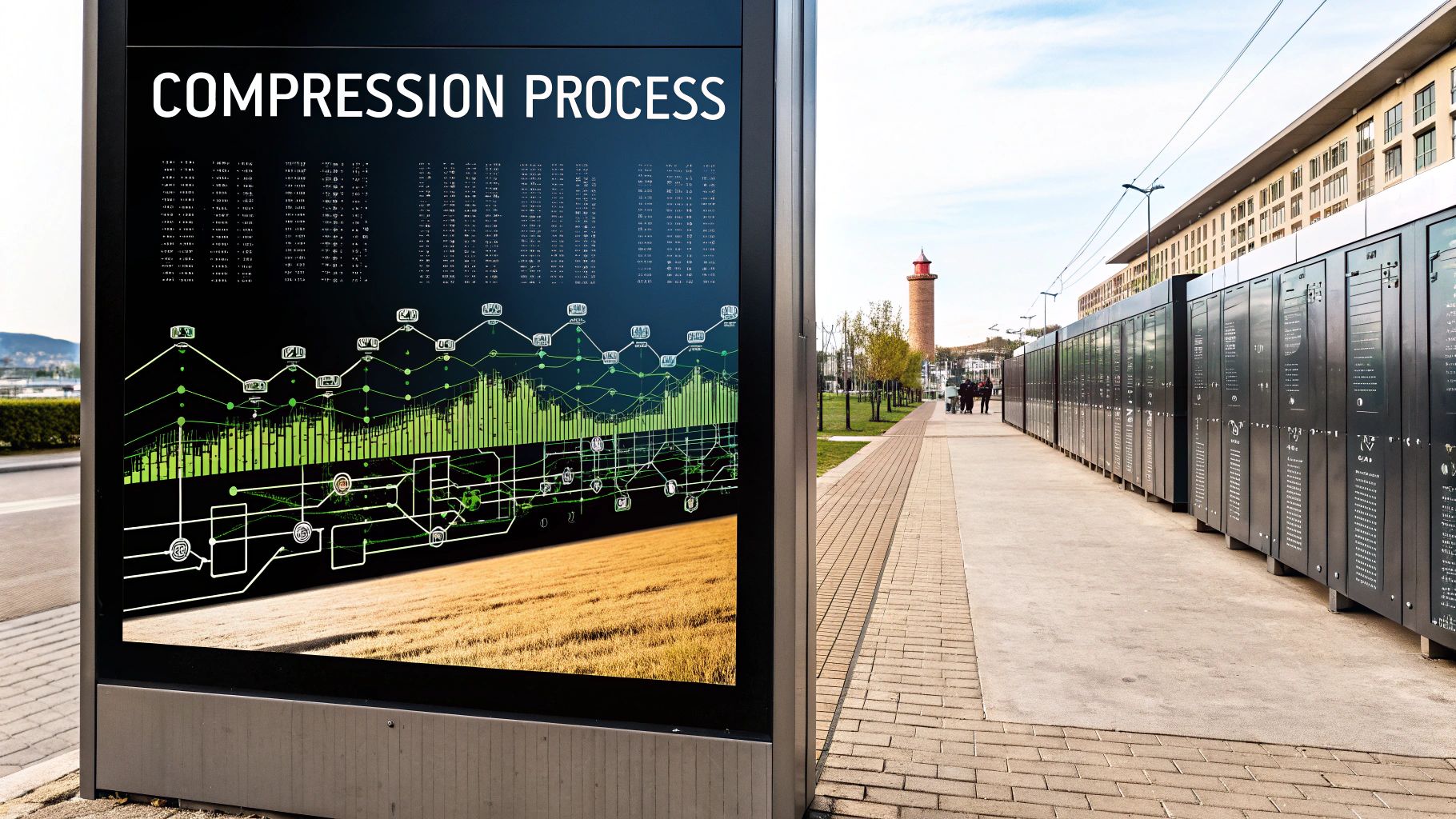Automatic video compression: Boost Quality & Reduce Size
Demystifying Automatic Video Compression

Automatic video compression has become essential for delivering high-quality video content efficiently. This technology shrinks video file sizes without major quality loss, simplifying storage, transmission, and streaming across different devices and platforms. This is a huge improvement from the early days of digital video.
The concept of video compression dates back to a 1929 patent for coding successive image differences. This fundamental idea has spurred progress over the decades, leading to today's advanced algorithms. An early standard, H.261 (1988), introduced the hybrid block-based coding still used in standards like MPEG-4 and H.264. This standard supported resolutions up to 352x288 pixels, paving the way for modern high-definition video. Explore this topic further for more on the history of video compression.
How Automatic Video Compression Works
Modern automatic video compression uses complex algorithms to analyze video content frame by frame. These algorithms find redundant data and apply techniques like inter-frame compression and intra-frame compression. Inter-frame compression uses similarities between consecutive frames. Intra-frame compression reduces redundancy within a single frame.
This dynamic approach allows for substantial data reduction while preserving visual quality.
When setting up your automatic video compression workflow, tools like a Lyric Video Maker can be integrated. For example, compressing a finished lyric video ensures efficient storage and delivery.
Key Benefits of Automation
Switching from manual to automatic video compression offers significant advantages. Automation eliminates time-consuming manual tweaks, freeing up valuable time and resources. Automatic systems consistently apply the best compression settings for the specific video, leading to better results than manual methods.
- Improved Efficiency: Process large numbers of videos quickly and consistently.
- Consistent Quality: Maintain great visuals across all your compressed videos.
- Reduced Storage Costs: Smaller files mean less storage space and lower costs.
- Enhanced Streaming Performance: Optimized files stream smoothly, even with limited bandwidth.
Choosing the Right Compression Solution
Selecting the appropriate automatic video compression solution depends on a few key things. Consider the level of compression needed, the desired video quality, and the processing power you have.
Different compression tools offer varying control and customization options. Some services provide cloud-based compression, while others are on-premise solutions. Finding the right balance is vital for optimal results.
The Evolution From Manual to Automatic Compression

In the early days of digital video, compression was a labor-intensive, manual process. Video experts painstakingly adjusted settings for each video, constantly balancing file size and quality. This approach was not only time-consuming but also often inconsistent, heavily reliant on individual expertise. Achieving optimal compression for many videos was simply impractical.
However, as computing power advanced, so did the complexity of compression algorithms. The development of new codecs, the software behind compression, became a key driver. This allowed for deeper analysis and more intricate calculations, paving the way for automation.
The Rise of Standardized Codecs
The 1990s saw the emergence of standardized codecs like MPEG-2, a significant step forward. These standards ensured compatibility across various devices and platforms. While still requiring some manual configuration, they streamlined the compression process and improved consistency. MPEG-2, for example, became widely adopted for DVD technology.
This standardization spurred further innovation, leading to the creation of more efficient codecs like H.264/AVC. H.264 provided significantly better compression than previous codecs, reducing file sizes while preserving quality. This paved the way for the streaming revolution we know today. As of November 2023, H.264 was used by an estimated 84-86% of video industry developers, demonstrating its market dominance. For more statistics on H.264 usage and the history of video compression, check out this article: The History of Video Compression. This widespread adoption signaled a pivotal shift towards automatic video compression.
The Dawn of Automatic Compression
The next major advancement was the introduction of automatic video compression. This removed much of the manual fine-tuning previously required. Algorithms began analyzing video content in real-time, dynamically adjusting compression settings based on motion, complexity, and bitrate.
This automation not only made compression more efficient but also ensured consistent quality across diverse videos and platforms. It marked a crucial step towards accessible and user-friendly video compression for everyone.
To illustrate the progression of automation in video compression, let's look at the following table:
This table compares key video compression standards and their features, showing the progression of automatic capabilities.
Evolution of Major Video Compression Standards
| Standard | Year Introduced | Key Features | Resolution Support | Compression Efficiency | Automation Level |
|---|---|---|---|---|---|
| MPEG-1 | 1993 | Basic digital video | Up to 4CIF (704x576) | Moderate | Limited |
| MPEG-2 | 1995 | Improved quality, interlaced video | Up to HDTV (1920x1080) | Good | Limited |
| H.264/AVC | 2003 | Advanced compression, improved efficiency | Up to 4K (4096x2160) | High | Moderate |
| H.265/HEVC | 2013 | Higher compression, wider color gamut | Up to 8K (8192x4320) | Very High | High |
| AV1 | 2018 | Royalty-free, open-source codec | Up to 8K (8192x4320) | Very High | High |
As you can see, later standards offer increased compression efficiency and support for higher resolutions, along with greater levels of automation. This trend continues to shape the future of video compression technology.
The Future of Compression: AI and Beyond
Today, automatic video compression continues its rapid evolution. Artificial intelligence (AI) and machine learning are playing an increasingly important role, enabling smarter and more adaptable compression. These technologies allow algorithms to learn from large datasets of video content, further refining compression efficiency and quality.
As a result, we can anticipate more powerful and user-friendly automatic compression tools in the coming years. This makes achieving optimal compression for practically any video a real possibility.
Inside the Magic: How Automatic Video Compression Actually Works

Ever wondered what happens behind the scenes when you upload a video and it plays back smoothly? The unsung hero is automatic video compression. This process analyzes your video frame by frame, making thousands of decisions every second to shrink the file size without sacrificing noticeable quality. It's a vital process for efficient storage, quick uploads, and seamless streaming.
Understanding the Algorithm
Automatic video compression algorithms are intricate systems designed to find and remove redundant data. Inter-frame compression is a core technique that leverages the similarities between consecutive frames. Imagine a flipbook – if one page is almost identical to the next, the algorithm only needs to store the changes. This significantly shrinks the file size, especially in scenes with minimal movement. For example, in a talking-head video, the background remains mostly static, enabling substantial compression.
Additionally, intra-frame compression examines each frame individually to remove unnecessary data within the image itself. This process mirrors image compression, identifying patterns and simplifying areas with uniform color or texture. The combined effect of these techniques creates a highly efficient compression process.
The Role of Machine Learning
Modern automatic video compression is increasingly powered by Machine Learning. These systems learn from enormous video datasets, discovering patterns and refining compression strategies for different types of video content. This adaptability means compression can be tailored to various genres, like action movies compared to online lectures, leading to even better results. Machine learning can also anticipate viewer attention, dedicating more data to visually prominent areas and less to areas viewers are less likely to notice.
Key Compression Concepts
Several essential concepts form the basis of automatic video compression. Perceptual quality modeling prioritizes preserving the visual aspects most noticeable to the human eye. Rate-distortion optimization finds a balance between file size reduction (rate) and quality loss (distortion) to find the optimal compromise. Adaptive quantization adjusts the level of detail stored in different video segments, giving more data to complex scenes and less to simpler ones. A fast-paced action sequence, for instance, will need more data than a static shot to maintain visual fidelity. You might be interested in: Compresto 1.5: New Auto-Compress Feature & Real-Time Progress Display for GIF for a closer look at how these concepts are put into practice.
Understanding these underlying principles helps you appreciate the capabilities of automatic video compression and make informed choices about your video workflows. From preparing videos for social media to ensuring smooth playback on your website, automatic video compression plays a crucial role in today's video landscape.
Real-World Benefits Across Industries and Platforms

Automatic video compression has become essential for many industries. It's not just about shrinking file sizes; it's about making video content more accessible and manageable. From entertainment platforms to educational resources, the ability to reduce file sizes without sacrificing quality has become a game-changer. This section explores the practical advantages this technology offers various sectors.
Streaming Services: Meeting High User Expectations
Imagine millions of people streaming movies and shows at the same time. Platforms like Netflix and Amazon Prime Video rely on automatic video compression to handle this massive demand. Without efficient compression, servers would struggle, leading to buffering and a poor user experience.
Automatic video compression allows these platforms to dynamically adjust video quality based on each user's internet speed. This ensures smooth playback, even during peak viewing hours. This not only increases user satisfaction but also helps control infrastructure costs.
News Organizations: Sharing Information Quickly
For news outlets, speed is critical. Automatic video compression allows them to quickly process and share breaking news footage globally. This ensures timely delivery of vital information while maintaining visual clarity.
It also helps reduce storage needs and transmission costs, key considerations for news organizations operating under tight deadlines and budgets.
E-Learning Platforms: Expanding Educational Access
E-learning platforms use automatic video compression to make educational content accessible to students with varying internet connections. Compressed video files ensure students, particularly those in areas with limited bandwidth, can access materials without excessive buffering or high data usage.
This promotes educational equity and expands opportunities for learners worldwide. For further insights, explore this guide on How to optimize videos for social media.
Social Media: Managing the Deluge of Video Content
Social media platforms face an enormous volume of user-generated videos daily. Automatic video compression is essential for handling this constant influx. It allows for rapid processing and storage of uploaded videos, enabling almost instant sharing and viewing across platforms. This real-time processing is a cornerstone of the social media experience.
Video Compression Benefits: A Detailed Look
To illustrate the far-reaching benefits of automatic video compression, let's explore how it impacts different industries. The following table provides a breakdown of key advantages:
Automatic Video Compression Benefits by Industry This table showcases how different sectors benefit from automatic video compression technology
| Industry | Key Benefits | Storage Savings | Bandwidth Reduction | Implementation Complexity |
|---|---|---|---|---|
| Streaming Services | Handles peak demand, improves user experience | Significant (up to 80%) | Substantial (up to 70%) | Moderate |
| News Organizations | Faster delivery of breaking news, lower transmission costs | Moderate (up to 50%) | Significant (up to 60%) | Low |
| E-Learning Platforms | Increased accessibility for students with limited bandwidth | Moderate (up to 40%) | Moderate (up to 50%) | Low |
| Social Media | Manages high volumes of user-generated content, enables real-time sharing | Significant (up to 70%) | Substantial (up to 65%) | Moderate |
This table shows that while storage and bandwidth savings vary by industry, the positive impact on user experience and operational efficiency is a constant across all sectors. The implementation complexity also remains relatively manageable, further emphasizing the practicality of this technology.
The Future of Video: Compression is Key
The examples highlighted above show the crucial role automatic video compression plays in delivering high-quality video efficiently and affordably. As video consumption continues to rise, this technology will become even more vital for businesses and individuals seeking to create, share, and access video content effectively.
Selecting Your Perfect Compression Solution
Finding the right automatic video compression method can feel overwhelming with so many options available. This guide helps you navigate the choices and find the best fit for your video projects, focusing on practical aspects rather than marketing hype. For a deeper dive into cost savings, check out this article on reducing operational costs.
Cloud-Based Compression Services
Cloud-based compression offers convenience and scalability. These services manage the technical complexities, letting you upload videos and receive compressed versions without needing specialized hardware or deep technical knowledge.
- Advantages: Easy to use, scales to handle large video quantities, and often provides extra features like format conversion and adaptive bitrate streaming.
- Disadvantages: Requires internet access, may incur costs for storage and bandwidth, and offers less control over compression settings than local software.
On-Premise Encoding Software
For more control over compression, on-premise software offers a robust alternative. Installing directly on your computer allows fine-tuning of compression parameters to match your exact requirements.
- Advantages: Precise control over settings, offline video processing, and potential long-term cost savings for high-volume users compared to cloud services.
- Disadvantages: Needs technical skill, requires hardware and software investment, and involves ongoing maintenance and updates.
Integrated Platform Options
Video platforms like YouTube and Vimeo often have built-in compression. This integration simplifies your process, automatically compressing uploads based on platform specifications.
- Advantages: Streamlined workflow, optimized for the specific platform, and usually included in the platform's service.
- Disadvantages: Limited compression setting control, possible file size and format restrictions, and dependence on the platform's capabilities.
Evaluating Compression Efficiency
Look beyond marketing claims. Ask vendors about their compression algorithms and performance data. Focus on relevant metrics like the quality-to-filesize ratio, balancing file size and visual quality. For more on optimizing files, see these file size reduction tips.
Also, consider encoding speed, especially for large video volumes. Faster encoding saves time and improves workflow. Ensure format compatibility across your target platforms and devices. Finally, analyze the cost structure, including fees, usage charges, and hardware costs, to understand the financial impact of each option.
Choosing the Right Approach
By carefully considering these aspects, you can select the best automatic video compression method for your needs. The ideal solution balances technical performance and business value, providing the optimal blend of quality, speed, and affordability. Whether you value ease of use, detailed control, or seamless integration, the right compression solution will improve your video processes and optimize your content for distribution.
Building Your Automatic Compression Workflow
Integrating automatic video compression into your video production process can be straightforward. Whether you're a solo video creator or part of a larger team, a well-defined workflow ensures consistent quality and saves you time. This guide provides practical advice for building a workflow tailored to your needs.
Defining Your Compression Goals
Before getting into technical specifics, clearly define your objectives. What level of compression are you aiming for? What platforms and devices will your videos be viewed on? What’s the acceptable balance between quality and file size? Understanding these goals will guide your decisions moving forward.
For example, social media videos might prioritize smaller files for faster uploads and mobile viewing. However, archiving high-resolution video footage requires prioritizing quality preservation.
Choosing the Right Compression Tool
Selecting the right automatic video compression software is essential. Evaluate different options based on your requirements and budget. Here are key factors to consider:
- Compression Efficiency: How much can the file size be reduced without significant quality loss?
- Encoding Speed: How fast can the software process your videos?
- Format Support: Does it support your input and output video formats?
- Customization Options: How much control do you have over compression settings?
- Integration with Existing Workflow: How easily does it fit into your current production process?
Some software offers cloud-based compression, while others are installed locally. Cloud-based services like Compresto are convenient for quick processing. Local software offers more control and handles larger files offline, like HandBrake.
Setting Up Your Workflow
After choosing your tool, design your workflow. Here's a basic framework:
- Input: Define your source video format and resolution.
- Compression Settings: Choose your desired compression level, bitrate, and output resolution.
- Processing: Compress your videos using the chosen software.
- Quality Control: Review the compressed videos. Adjust compression settings and reprocess if necessary.
- Output: Save the compressed videos in the correct format for your target platform.
Using presets for common output formats (like social media or web use) saves time and maintains consistency.
Advanced Workflow Considerations
For more complex needs, consider these additions:
- Folder Monitoring: Automate compression by having the software monitor a folder and automatically compress new videos.
- Batch Processing: Compress multiple videos at once to boost efficiency.
- Automated Quality Control: Integrate automated quality checks to ensure consistent results.
- Scalability: Select a solution that can handle increasing video volumes as you grow.
Troubleshooting and Optimization
Regularly monitor your workflow for bottlenecks and problems. Experiment with compression settings to balance file size and quality.
Common issues include over-compression, slow processing, or format compatibility problems. Addressing these proactively ensures a smooth and efficient workflow.
Ready to experience hassle-free video compression? Try Compresto today and optimize your video workflow! Get started with Compresto